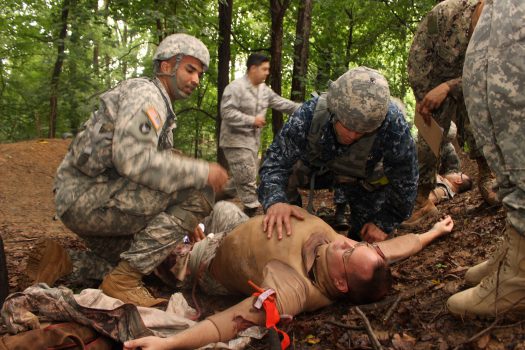
The US Army Medical Materiel Agency is currently putting a potentially life saving device through clinical trials.
Described as a surgical caulk gun, the device injects a self-expanding foam into wounds, stopping massive intracavitary abdominal bleeding. The current tests are to check its safety and effectiveness.
With the device receiving an Investigational Device Exemption in early 2017 from the US Food and Drug Administration, the next year will see the device go through clinical trial sites and complete pre-study approvals.
Regulatory support for the project is provided by US Army Medical Materiel Development Activity, which is also part of USAMRMC. The anticipated start date of the pivotal clinical trial is 2018.
“Right now, we are looking at this device as a potential stop-gap for patients awaiting surgical care,” said Leigh Anne Alexander, USAMMA product manager. “This is not going to repair the injury but it could be a ‘bridge to surgery,’ keeping the patient alive long enough to give them a fighting chance at survival.”
Once injected into a trauma patient, the device mixes two separate chemicals causing the product’s material to rapidly expand inside the abdomen to about 35 times its original volume. The foam is designed to expand around the patient’s internal organs to stop bleeding and can be left inside the patient for up to three hours.
Exsanguination, or bleeding to death, remains the most common cause of potentially survivable death to wounded warfighters. A study published in the Journal of Trauma and Acute Care Surgery in 2012 reviewed nearly 5,000 battlefield fatalities from 2001-2011, categorising them into two groups: non-survivable and potentially survivable. Of those that were considered potentially survivable deaths, more than 90 percent were related to haemorrhage. Of those deaths, more than 67 percent were related to truncal (trunk of the body) haemorrhage.
Military medical is therefore focussed on identifying and developing solutions to these types of trauma. The wound stasis program from which this study derives began in 2010 at the Defense Advanced Research Project Agency. Under that program, DARPA collaborated with a private vendor, along with the Massachusetts General Hospital and the Harvard Medical School, to develop a novel, self-expanding polyurethane foam that rapidly compresses major abdominal bleeding due to trauma. The project transitioned to the Army in 2015 after promising animal study results.
Image: Select second-year medical students at the Uniformed Services University of the Health Sciences F. Edward Hebert School of Medicine participate in the Advanced Combat Medical Experience Teacher Assistant Course. Volunteer role players wearing latex cut suits that bleed artificial blood to simulate battle injuries allow medical students to apply simulated medical interventions such as haemorrhage control, cricothyrotomy, and bilateral anterior and axillary needle thoracentesis.
If you would like to join our community and read more articles like this then please click here








